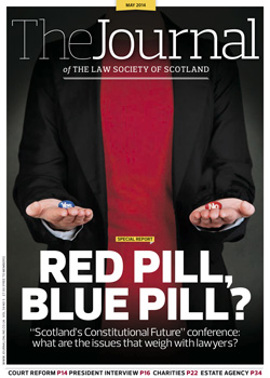LBTT: key points for solicitors

Last month the Head of Revenue Scotland, Eleanor Emberson, outlined the developing arrangements for the taxes devolved to Scotland in the Scotland Act 2012. This month, I should like to introduce myself and talk about the key features of the Land and Buildings Transaction Tax (LBTT) that will replace Stamp Duty Land Tax (SDLT) in Scotland on 1 April 2015. (A future article will give more information about plans for the transition from SDLT to LBTT.)
I was delighted to join the Scottish Government in May 2013, having spent nearly 25 years with HMRC (and both its main predecessor departments) in a wide range of tax professional roles, covering compliance and enforcement, risk and operations management, project and programme management, and latterly as Head of Stamp Taxes and Anti-Money Laundering Supervision. As Chief Operating Officer of Revenue Scotland, I am responsible for the collection and management of Scotland’s devolved taxes: LBTT and Scottish Landfill Tax (SLfT).
The Revenue Scotland and Tax Powers Bill, currently going through the Scottish Parliament, will establish a distinctive framework for the administration and enforcement of the devolved taxes, including a General Anti-Avoidance Rule (GAAR). This will underpin LBTT as a self-assessed tax with an active and risk-targeted enquiry and investigation regime.
The Land and Buildings Transaction Tax (Scotland) Act completed its passage through the Scottish Parliament on 25 June 2013 and received Royal Assent on 31 July 2013. While LBTT has many similarities to SDLT, it is different, and fits Scots law and practice more closely.
Progressive structure of rates and bands
LBTT is structured as a progressive tax. This means that each tax rate applies only to the portion of the purchase price within the relevant rate band. This progressive approach should remove the distorting effects on the property market from SDLT’s “slab” structure, where the highest tax rate chargeable applies to the whole price. We expect the first set of LBTT rates to be announced by Scottish Ministers this autumn as part of the annual budget process in the Scottish Parliament.
The block grant from Westminster will be reduced to take account of the devolved taxes (and, from 2016, the Scottish Rate of Income Tax). So the revenue raised by LBTT will become a small but important element of Scotland’s public finances.
Linkage with land registration process
While Revenue Scotland will be the tax authority, accountable to the Scottish Parliament, we will delegate some LBTT functions to Registers of Scotland (RoS). We are working closely with RoS and practitioners to devise and develop systems that are primarily electronic and online and put user experience first, in keeping with the Scottish Government’s “Digital First” agenda. For example, we are closely linking the LBTT return with the land registration application. This will mean that a land registration will not be able to proceed unless the linked LBTT return is complete and arrangements made for payment of the tax. It is worth noting that an LBTT return may be required for land transactions that do not have to be registered, such as some partnership transactions, or where no tax is due. An article in the coming months will discuss our IT systems and processes in more detail.
Treatment of non-residential leases
LBTT adopts a new approach to taxing leases, informed by a working group of tax professionals, including representatives from the Law Society of Scotland. This better aligns the taxation of non-residential leases with Scots law and practice. Residential leases will generally be exempt. For non-residential leases, as with SDLT, an initial payment will be made at the start of a lease, based on expected rent payments. After that, under LBTT, the taxpayer will be required to compare actual rent paid with the previous estimate every three years and make any necessary adjustments: further payment or claim for refund. This will ensure that LBTT reflects the actual consideration for the lease throughout its lifetime. Returns will be required where leases are assigned and at the end of the term of a lease.
Treatment of licences to occupy retail premises
Licences to occupy retail premises will also be within the scope of LBTT, to ensure fair tax treatment between retail premises occupied under a lease and those occupied under licence.
Next steps
We welcome contributions to the Scottish Government’s consultation document on the LBTT regulations and the licence issue above, available at www.scotland.gov.uk/publications/2014/05/8387
I have been struck by the helpful, informed input received from a wide cross-section of stakeholders, including the Law Society of Scotland, in getting us to this point and I look forward to working with you in developing our website, our guidance and our taxpayer contact function, among other things, as we move towards implementation.
In this issue
- Immigration: where British nationals lose out
- Family actions: be prepared
- The psychology of post-adoption contact
- Attack vectors into the law: Heartbleed
- When family farming partnerships go wrong
- Reading for pleasure
- Opinion: Gillian Mawdsley
- Book reviews
- Profile
- President's column
- The results are in
- The best medicine?
- LBTT: key points for solicitors
- Courts: why the reforms add up
- Unfinished business
- The voice of technology
- Capacity: a growing issue
- Charities and the rise of social enterprises
- Referendum – the rules of debate
- Rewriting the rules
- Family leave – bedevilled by detail
- Strictly confidential?
- Budget: your flexible friend
- Scottish Solicitors' Discipline Tribunal
- Food for thought
- The consumer protection challenge
- People on the move
- Ask us another
- Healthy discord
- Claims, trends and targets
- Ask Ash
- Law reform roundup
- Cost of Time 2014: survey now open






